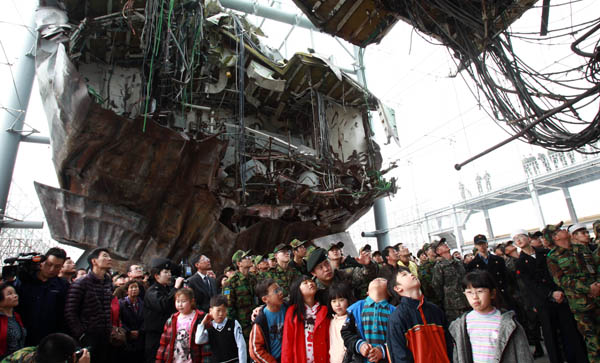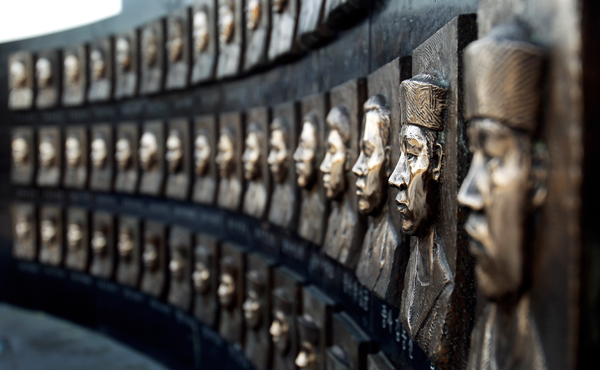Two years on, sinking of Cheonan still divides

Visitors to the Second Fleet Headquarters in Pyeongtaek, Gyeonggi, look up Thursday at the mangled remains of the parts of the 1,200-ton naval corvette Cheonan, which sank on March 26, 2010 after a torpedo attack by a North Korean midget submarine. By Park Sang-moon
‘I don’t understand how people can be so cruel,’ says the father of one sailor who died on the Cheonan. ‘It’s like they’re killing my son all over again.’
PYEONGTAEK, Gyeonggi - The wreck of the warship Cheonan, sundered and mangled by an explosion two years ago today, is on display at the Second Fleet Headquarters in Pyeongtaek, Gyeonggi, on the Yellow Sea. Hundreds of people went to see it Thursday, a few days before the anniversary. They included military men, their families and regular civilians.
“I feel sorry that the blowing up of the Cheonan is sinking from people’s memory,” said Won Hyeon-muk, a Navy captain. “Seeing its remains, I remember the tragedy and am reminded of the importance of national security.”
A group of mothers brought their children to see the remains, and 200 soldiers and sailors came to get a glimpse of the naval vessel as part of their mandatory military service.
“Most of us have husbands working in the military so we just want to teach our kids about the attack and the importance of national security,” said Lee Ok-jin, a 39-year-old mother who came from distant city of Hwacheon, Gangwon.

A monument to the 46 sailors who died has been erected on a cliff on Baengnyeong Island from which visitors can see the sea where the Cheonan was attacked and sunk. By Kim Tae-sung
Two years ago today, the 1,200-ton Navy ship with a 104-member crew was on a routine patrol mission near Baengnyeong Island, just south of the Northern Limit Line, a disputed sea border with North Korea in the Yellow Sea. An explosion at 9:22 p.m. ripped it in two and the ship sank. Rescuers saved 58 sailors, including the captain. Trapped in the sinking vessel, the remaining 46 sailors perished. Six of their bodies were never found.
“We have never forgotten the 46 martyrs of the Cheonan,” Jang Seok-yong, a lieutenant commander at the naval base, said. “We are ready to strike back at any enemy. If the enemy provokes us again, we will severely punish them.”
One of the reasons the military is giving tours of the Cheonan wreck is to convince doubters of the government’s official conclusion that a North Korean torpedo sunk the corvette.
“We determined to show the Cheonan, the most definite evidence of all, as part of our efforts to resolve all suspicions and boost our national security education program,” said Jang Eun-ji, a female naval officer who was one of the tour guides. “Searching for information on the Cheonan online is one thing, but we hope to give you a better understanding of the tragedy by letting you see the vessel in person.”
According to the Navy, approximately 350,000 visitors have taken the free Navy tour.
The program includes a visit to the West Sea Protection Hall, where belongings of the dead sailors are displayed, including their uniforms, driver’s licenses and letters written by their friends after the tragedy, along with a documentary describing the sinking.
“Roughly 1,000 people visit here every day and the tours are held three times a day,” Jang said. “The most frequent question we receive from visitors is how a small, single torpedo could have split such a large vessel in two.”
Despite the passage of two years, some people doubt or reject both the idea that North Korea sank the Cheonan and the conclusions of the government-led forensic investigation, which had the input of investigators from the United States, the United Kingdom, Canada, Australia and Sweden. North Korea denies sinking the ship; liberals are particularly doubtful.
According to the 308-page White Paper issued by the Defense Ministry, a 250-kilogram (551 pound) torpedo exploded 6 or 9 meters (20 or 30 feet) beneath the Cheonan the night of March 26, 2010. The explosion created a massive “bubble jet” shock wave that split the ship in two.
“A single torpedo can generate the force of 4,000 hand grenades,” Jang said. “In 1999, an Australian vessel was split in two by a torpedo during an experimental explosion. It took 1.5 seconds to blow the ship in two. In modern military operations, a submarine doesn’t attack the enemy by shooting a torpedo directly at the ship. They indirectly attack it by exploding a torpedo underneath, because the effect is much bigger than a direct hit.”
Pointing at the wreck of the ship, Jang said, “We guess that the six missing sailors would have been in the gas turbine room and the master control room, which were blown away by the explosion.”
The official investigation found a torpedo propeller in the waters near the wreck marked “1-beon” (number 1 in Korean), which it said identified it as being North Korean. The propeller matched a blueprint of a North Korea-built CHT-02D torpedo the military obtained earlier.
North Korea called the evidence “fabrication” and refused to admit or apologize for the sinking. President Lee Myung-bak imposed sanctions on Pyongyang on May 24, 2010, and since then, inter-Korean relations have been icy.
A number of challenges were made to the official investigation, such as: Why weren’t the bodies of recovered, dead sailors burned by the underwater explosion? How did the hand-written mark on the propeller survive the explosion? Why weren’t other components of the torpedo recovered? Why was the iron propeller unit covered with rust when it was pulled from the sea?
“Although we have put the vessel on display for anyone to see, many people are raising theories and suspicions [against the government’s report],” Jang said. “But most of them don’t bother to come examine the ship.”
The official investigation became an issue in June 2010 legislative by-elections, with attitudes divided along the usual ideological lines. Opposition liberals argued that the government’s report was an absurd scenario covering up flaws in the national security system and mistakes by the Navy and demanded a reinvestigation of the case by a civilian-led panel. Ruling party lawmakers lambasted the opposition, saying they were heedless of national security and pro-North Korea.
Lee Jeong-guk, a representative of the families of 46 sailors who died, said the families were wounded by criticisms of the Navy.
“Some said that the sailors were dead because they weren’t disciplined, and that we earned a lot of money because of their deaths,” said Lee, whose younger brother died on the Cheonan. “Some people even said the dead sailors were ‘defeated’ in the battle with North Korea.”
After two years, Lee said, the issue has become a political spat rather than a significant event in the nation’s national security.
“When I made comments supporting the Navy,” he said, “I was condemned as being a hardline conservative.”
“An opposition candidate running a by-election told me that he definitely thought it was an attack by North Korea, but he couldn’t help saying he doubted it in order to win the race as a liberal,” Lee said. “In a grave matter of national security, I don’t think politicians should make everything political.”
Lee actually lost a job because of his connection to the Cheonan tragedy and people’s lack of belief in the government’s explanation.
“When I would attend a meeting, clients kept asking me about the tragedy,” he recalls. “Wherever I went, people kept asking me about it. I couldn’t concentrate on my job, and my employer asked me to leave.”
Lee believes the government should have given more explanations and refuted groundless rumors.
“Although there are always people who make money by raising suspicions,” he said, “I think the government and the military should give more persuasive explanations.”
Jo Yeong-bok, whose son died in the Cheonan, said that people who doubt the government’s investigation and spread rumors should be more cautious. “Although they didn’t experience this incident as we did, I want them to be cautious when they say something [suspicions],” Jo told the JoongAng Ilbo.
Jang Man-su, who also lost his son, said, “I don’t understand how people can be so cruel. It really hurts me to read these unfounded rumors. It’s like they’re killing my son all over again.”
The Foundation for the Cheonan Warship, established by families with donations from the public, said it will publish a memoir of the tragedy with vivid descriptions of the sinking, the rescue and the aftermath of the tragedy as recalled by the sailors on board.
“The purpose of the memoir is to remind people of the tragedy through the words of the sailors,” Yu Jung-geun, secretary general of the foundation, told the JoongAng Ilbo.
“We have focused too much on who was the culprit in the tragedy, not on the stories of people who died and who lived through it,” said Kwon Su-in, the author of the book.
By Kim Hee-jin [heejin@joongang.co.kr]










with the Korea JoongAng Daily
To write comments, please log in to one of the accounts.
Standards Board Policy (0/250자)